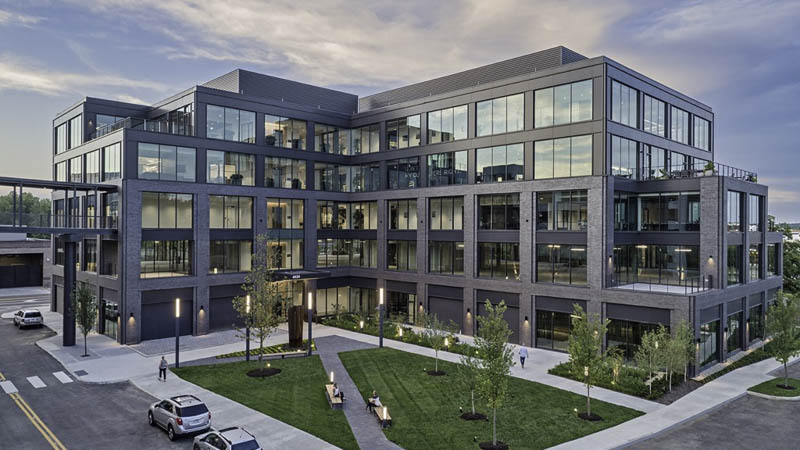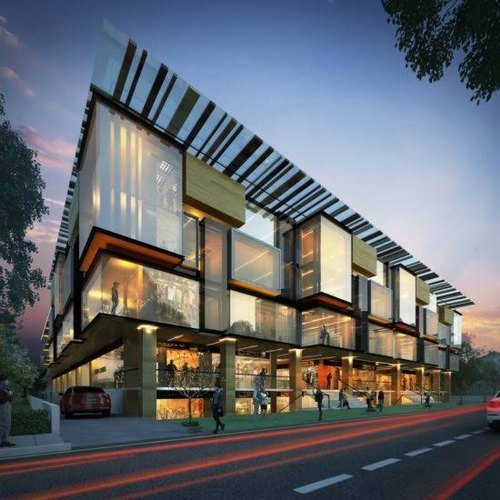Discover the Innovative Solutions Supplied by Commercial Architects for Your Following Job
Commercial architects play an essential function in forming the developed setting. They blend capability with aesthetic charm, developing rooms that reverberate with brand name identification. These specialists employ innovative layout services, sustainable methods, and advanced modern technologies to enhance user experiences. Their collaborative method guarantees alignment with customer visions and functional demands. The degree of their solutions usually extends beyond layout. The following steps in recognizing how these architects browse intricate task demands may stun you.
Comprehending the Function of Commercial Architects
Although the duty of industrial architects may differ depending on the particular job, their main feature focuses on creating useful and cosmetically enticing rooms for companies. These specialists are entrusted with recognizing the one-of-a-kind demands of each customer, whether it be a retail store, office structure, or commercial facility. They perform comprehensive website evaluations and work together with stakeholders to guarantee that the layout lines up with business goals and brand name identity.Commercial architects likewise browse different regulative requirements, safeguarding compliance with zoning legislations and building ordinance. Their proficiency encompasses producing sustainable designs that advertise energy efficiency and ecological obligation. In addition, they handle the project's timeline and spending plan, collaborating with specialists and engineers throughout the construction procedure. By blending creative thinking with technical understanding, commercial architects play a necessary role in transforming theoretical concepts into substantial truths, inevitably boosting the performance and allure of commercial areas.
Innovative Style Solutions for One-of-a-kind Spaces
As business spaces progressively require distinctiveness to stand out in open markets, innovative style remedies have ended up being vital for architects. These specialists leverage their imagination and technical expertise to craft distinct settings that reflect brand name identification and boost user experience. By integrating innovative modern technology and materials, commercial architects can transform common rooms right into charming locations that engage clients and influence employees.Architects use numerous strategies, such as adaptive reuse, which revitalizes existing frameworks while maintaining their historic value. They additionally discover unconventional layouts and multifunctional spaces that satisfy varied demands, guaranteeing flexibility for future growth.Furthermore, the incorporation of biophilic layout-- bringing nature inside-- develops welcoming ambiences that advertise wellness - commercial architects. This attention to detail in cutting-edge layout not just addresses visual problems yet also fosters community and collaboration. Ultimately, these tailored services allow companies to flourish in an ever-evolving landscape, setting them besides rivals
Sustainable Architecture Practices
Sustainable architecture techniques have actually arised as a crucial emphasis for business architects seeking to create impactful layouts that resonate with environmental stewardship. These techniques focus on the use of renewable sources, energy efficiency, and marginal waste, showing a dedication to lowering the environmental footprint of structures. Architects integrate materials that are sustainably sourced or reused, ensuring that construction techniques line up with eco-friendly principles.Furthermore, the assimilation of green roofs and walls enhances biodiversity while boosting power performance. Efficient water administration systems, such as rainwater harvesting, add to sustainability by saving water sources. Natural air flow and daylighting strategies are additionally used to optimize interior environments, decreasing reliance on synthetic home heating and illumination.
Integrating Innovation in Architectural Layouts
A raising number of industrial architects are welcoming technology as a transformative aspect in building layout. By leveraging advanced software application tools such as Building Info Modeling (BIM), architects can develop detailed 3D representations of jobs, enabling enhanced visualization and partnership amongst stakeholders. This modern technology helps with real-time adjustments, reducing mistakes and improving the style process.Additionally, architects are incorporating clever structure technologies right into their layouts, which enhance power performance and resident comfort. Functions such as automated lights, environment control, and safety and security systems can be effortlessly included, advertising sustainable methods and lowering operational costs.The use online and augmented fact additionally permits customers to experience styles prior to construction begins, offering vital insights into spatial relationships and visual choices. Ultimately, the integration of innovation in architectural layouts not just fosters development yet additionally assures that projects are performed with precision and straightened with modern demands.

Task Administration and Control Solutions
Effective project administration and sychronisation services are essential for the successful implementation of industrial building projects. These services ensure that all facets of a project, from first design to final building and construction, are effortlessly incorporated. Commercial architects play a considerable duty in coordinating in between different stakeholders, consisting of clients, specialists, and suppliers, to maintain clear communication and placement on task goals.By executing organized approaches, architects can take care of timelines, spending plans, and resources successfully, decreasing delays and expense overruns. They use task monitoring software and tools to track development, handle documents, and facilitate collaboration among group members.Additionally, these solutions include threat evaluation and reduction methods, verifying potential challenges are determined and attended to proactively. The result is a streamlined procedure that enhances general task effectiveness and top quality, inevitably causing a successful result that meets the client's vision and expectations.
Governing Conformity and Zoning Help
Efficient governing compliance and zoning help are crucial for the success of any commercial job. Architects must have a deep understanding of regional regulations and zoning regulations to lead clients via the complexities of the approval process. This competence not just assures adherence to legal try here requirements however additionally aids optimize job design and functionality.
Browsing Local Laws
How can commercial architects ensure their designs line up with neighborhood guidelines? By staying well-informed regarding the ever-evolving landscape of building codes and regional ordinances, architects play an essential function in making sure conformity. They carry out detailed study to comprehend the particular policies governing materials, safety and security requirements, and building and construction methods suitable to each job. Teaming up closely with neighborhood authorities, commercial architects can navigate through the intricacies of governing frameworks effectively. They likewise promote needed authorizations and evaluations, streamlining the approval process. This aggressive technique not just mitigates prospective lawful difficulties but also improves task efficiency. Ultimately, their experience in maneuvering local laws equips customers to realize their vision while adhering to all called for criteria and guidelines.
Zoning Legislation Knowledge
Zoning regulation proficiency is necessary for commercial architects guiding with the intricacies of land use guidelines. These architects have in-depth understanding of regional zoning codes, which control residential property development, land use, and building specs. By recognizing these guidelines, they assist clients browse the often complex authorization procedures needed for building projects. Their proficiency guarantees conformity with zoning legislations, lessening the risk of task hold-ups or legal complications.Additionally, commercial architects give useful support in getting essential permits and differences, promoting smoother interactions with neighborhood authorities. They likewise provide strategic referrals to enhance site format and maximize the possibility of a residential property while sticking to zoning limitations. Ultimately, their zoning regulation proficiency plays a crucial role in the successful realization of commercial jobs.
Collaborative Techniques With Customers and Stakeholders
Successful industrial style depends upon the ability to promote solid collaboration with customers and stakeholders throughout the style procedure - commercial architects. Architects involve in open dialogues, making sure that all parties' visions and requirements are incorporated into the job. This joint approach starts in the first phases, where architects carry out workshops and conceptualizing sessions, permitting customers to verbalize their objectives and concerns.Stakeholder input is similarly important; architects commonly arrange meetings with neighborhood participants, city governments, and other appropriate entities to collect varied perspectives. By utilizing visualization tools, such as 3D modeling, architects assist in far better understanding and communication.This iterative feedback process not only improves style high quality but also constructs depend on, leading to even more effective outcomes. Eventually, the joint approach of commercial architects transforms concepts right into practical rooms that mirror the ambitions of customers and the more comprehensive area, ensuring a harmonious relationship throughout the project lifecycle

Frequently Asked Inquiries
What Is the Regular Timeline for an Industrial Design Job?
The typical timeline for a business design task varies, generally extending useful content 6 to 18 months. Elements affecting this period include job complexity, regulative approvals, and customer responsiveness, impacting each stage from design to building and construction completion.
Just How Do Commercial Architects Charge for Their Providers?
Commercial architects usually bill based on task scope, intricacy, and size. Usual fee frameworks include per hour rates, repaired costs, or percentage-based fees determined from the complete building price, ensuring transparency and placement with client expectations.
Can Commercial Architects Aid With Interior Decoration?
Commercial architects can without a doubt assist with interior layout, integrating performance and visual appeals. Their competence warranties natural spaces that straighten with architectural vision, enhancing customer experience while meeting governing demands and customer goals through ingenious design remedies.
What Sorts of Customers Do Commercial Architects Usually Deal With?
Commercial architects commonly collaborate with diverse customers, consisting of services, government entities, academic organizations, and charitable companies (commercial architects). Each customer looks for customized building solutions to meet specific functional and aesthetic needs for their tasks and environments
How Do Commercial Architects Remain Updated With Style Patterns?
Commercial architects remain upgraded with layout fads via continuous education and learning, attending sector conferences, taking part in specialist networks, and looking into emerging technologies. They likewise team up this hyperlink with other professionals to acquire insights right into cutting-edge products and style practices.